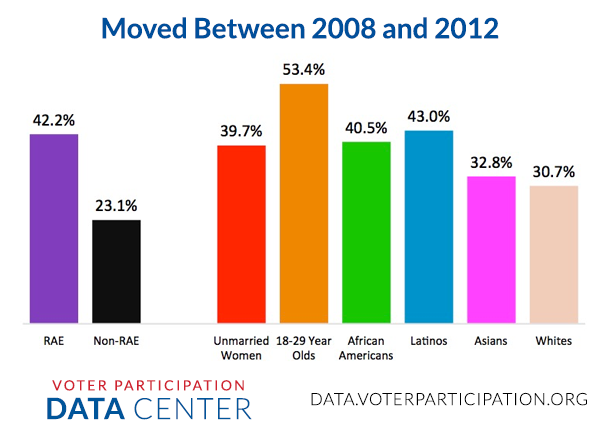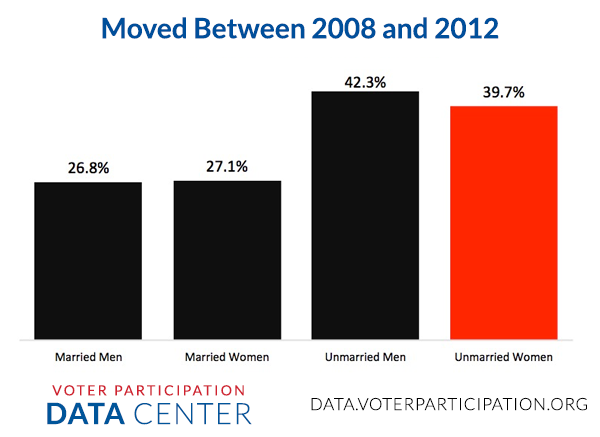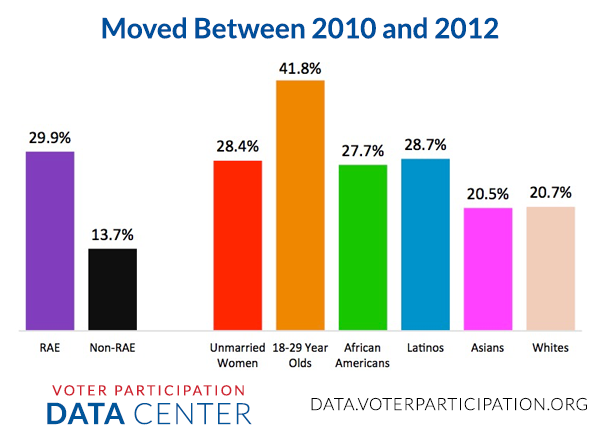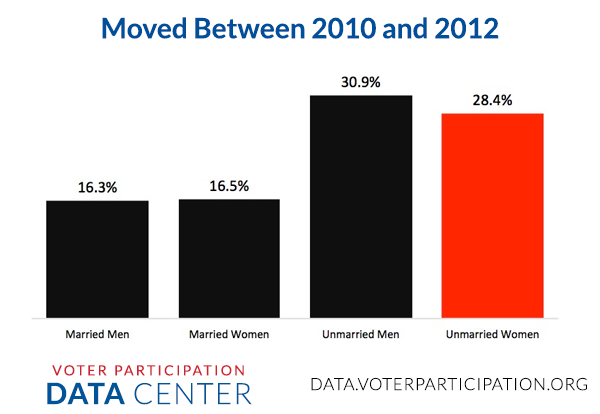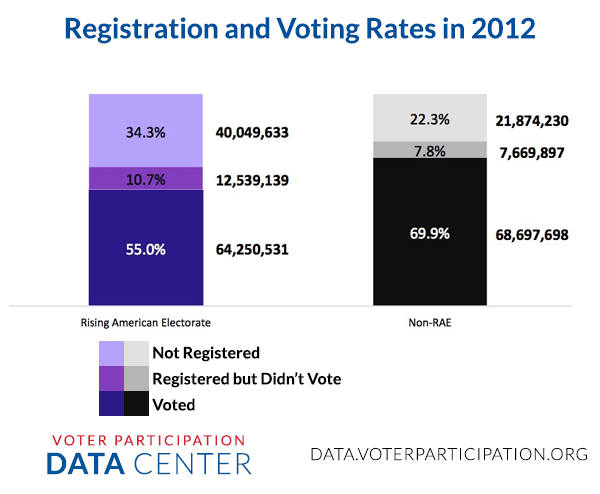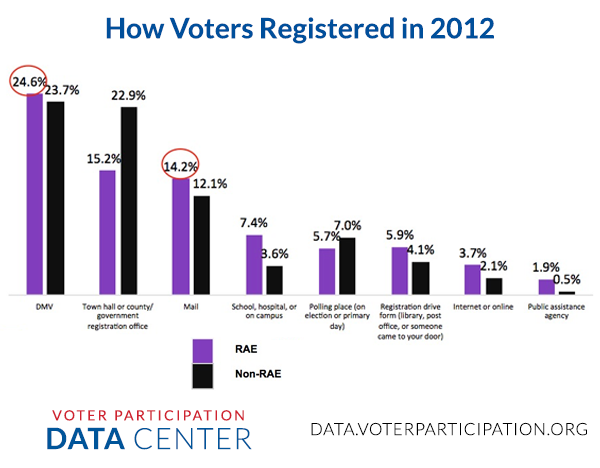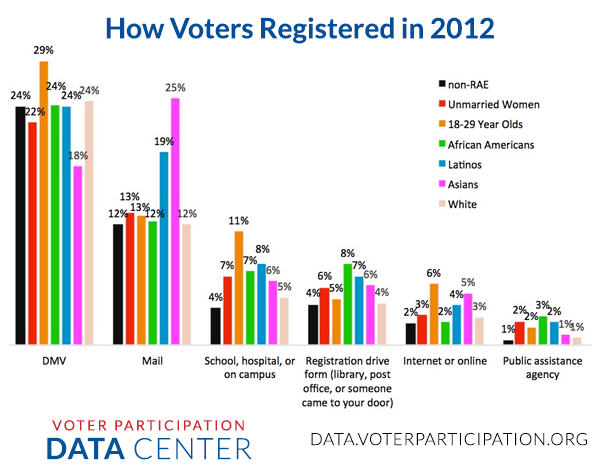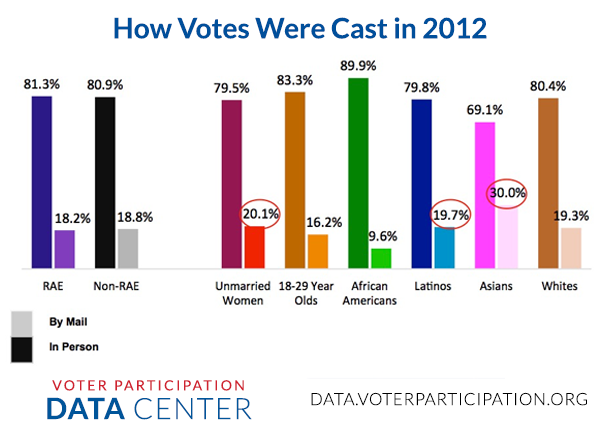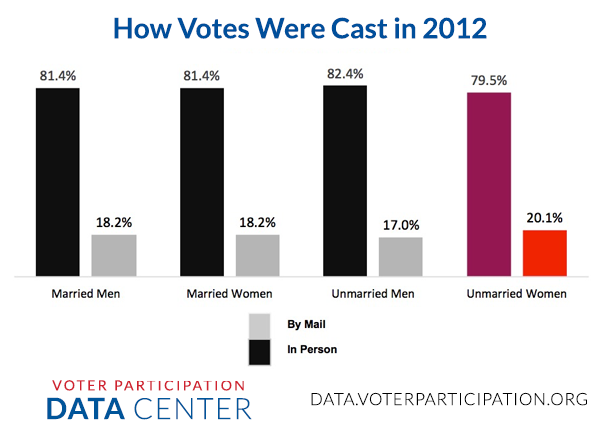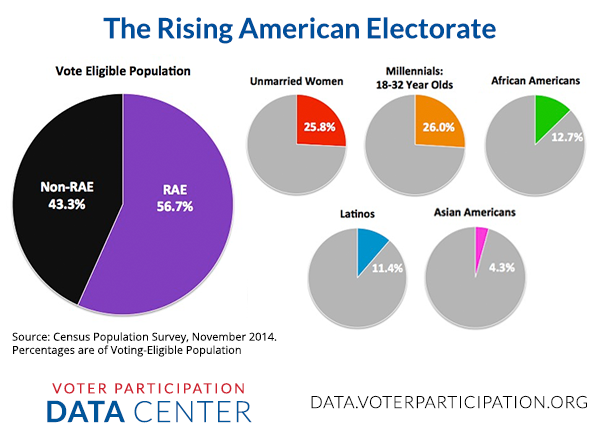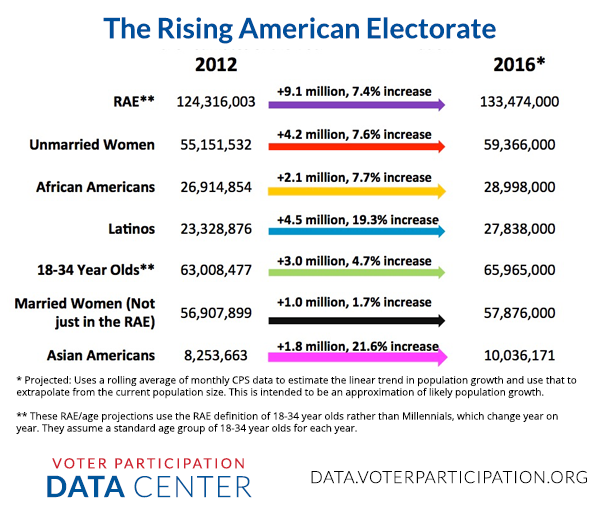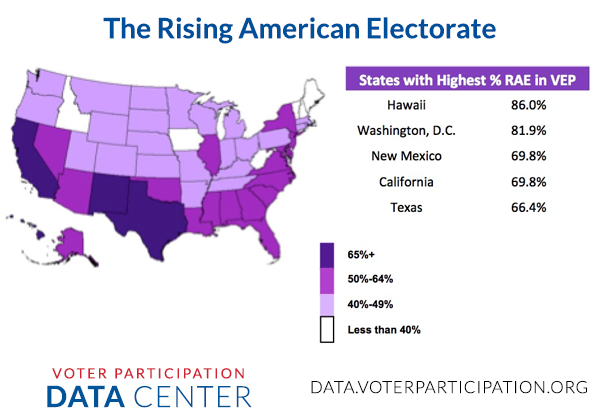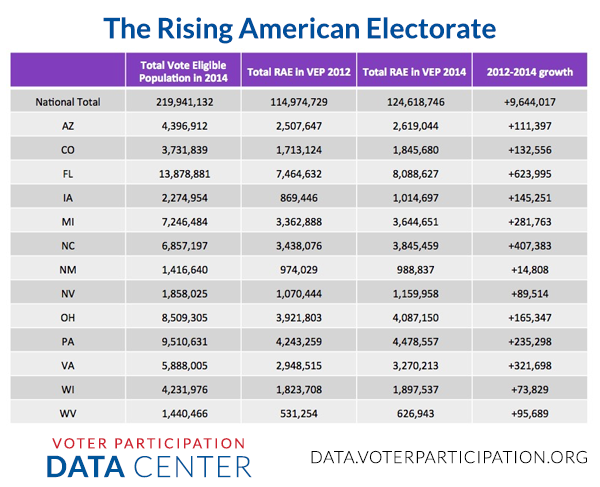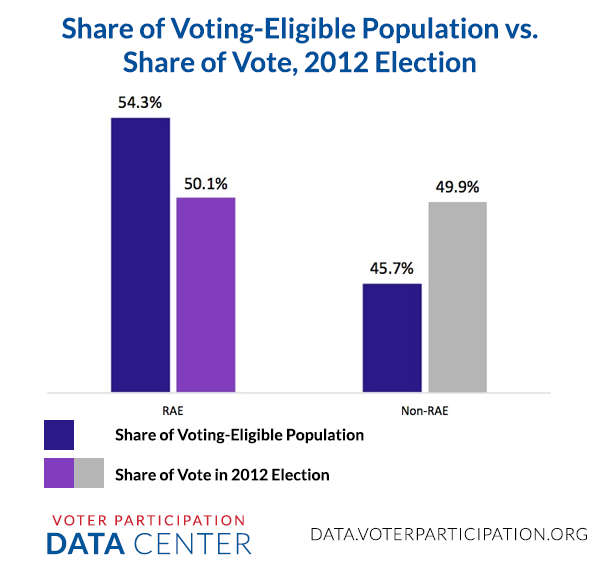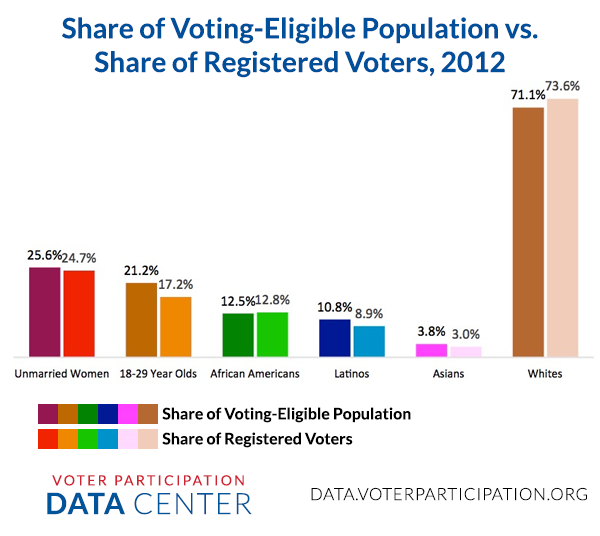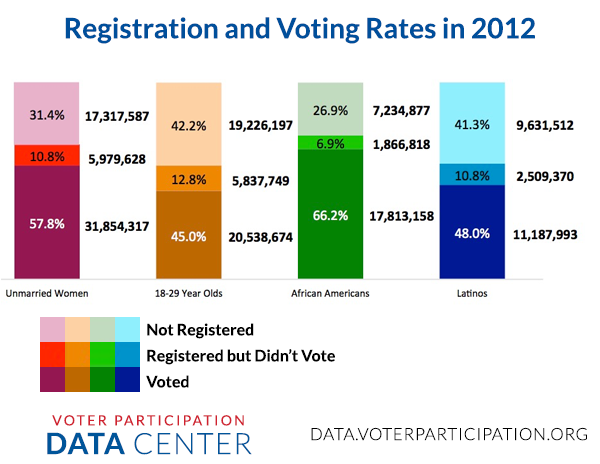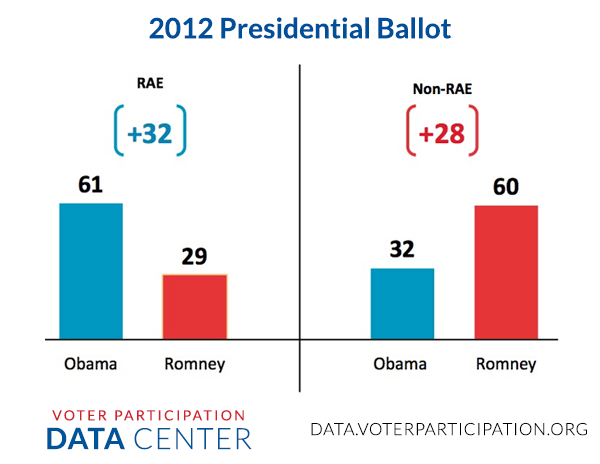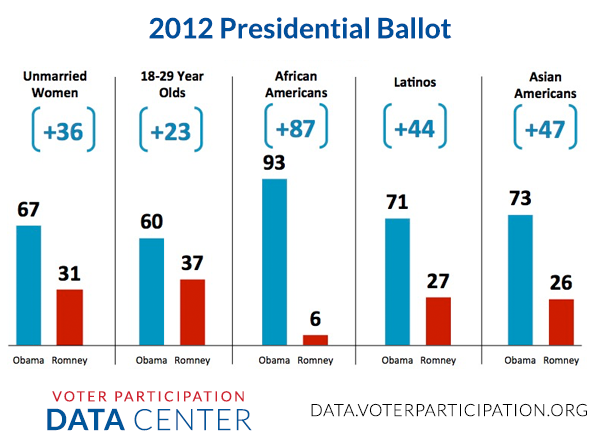The Rising American Electorate: A Population on the Move
The Rising American Electorate (RAE) — unmarried women, people of color and young people 18-35 (Millennials) – are highly mobile. Four in ten RAE members moved between the 2008 and 2012 presidential elections and lost their registration status. That makes the re-registration of movers a top priority if the RAE share of the electorate is ever going to match its share of the population of citizens eligible to vote.
Unmarried men and women were more likely to move than married men and women.
Young voters were the most likely to have moved between 2010 and 2012.
More than one in four unmarried women moved between 2010 – 2012.
An in-depth demographic, economic and political look at unmarried women and the Rising American Electorate from Lake Research Partners.
- Unmarried Women: A Demographic and Economic Profile
- Unmarried Women: An Electoral Profile
- The Rising American Electorate: A Profile
- How the Rising American Electorate Register and Vote
- The Rising American Electorate: A Population on the Move
How the Rising American Electorate Register and Vote
About a third of the Rising American Electorate (RAE) – unmarried women, people of color, young voters 18-35 (Millennials) — are not registered to vote.
Convenience of registration matters: The RAE is most likely to register at the DMV or by mail.
The majority of the RAE votes in person.
Unmarried women, one of the largest groups within the RAE – are the most likely to vote by mail.
An in-depth demographic, economic and political look at unmarried women and the Rising American Electorate from Lake Research Partners.
- Unmarried Women: A Demographic and Economic Profile
- Unmarried Women: An Electoral Profile
- The Rising American Electorate: A Profile
- How the Rising American Electorate Register and Vote
- The Rising American Electorate: A Population on the Move
The Rising American Electorate: A Profile
The fast-growing Rising American Electorate (RAE) – unmarried women, people of color and young people 18-35 (Millennials) — now account for more than half (56.7 percent) of all eligible voters in the United States.
All of the groups that make up the RAE are growing rapidly and by 2016, they will likely cast over half of all ballots, making them the majority of the electorate.
The RAE population is growing all across America.
While RAE turnout has increased in recent elections, they still do not vote in proportion to their share of the population.
There is a gap in almost all RAE groups between the number of RAE members who could vote and those who do.
About a third of the RAE is not registered to vote.
Latinos and young people are the least likely to be registered.
RAE turnout in 2012 was 55 percent, compared to an almost 70 percent (69.9 percent) turnout by the rest of the electorate. RAE members who voted in 2012 helped reelect President Obama.
All the groups that make up the RAE overwhelmingly supported President Obama.
An in-depth demographic, economic and political look at unmarried women and the Rising American Electorate from Lake Research Partners.
Unmarried Women: A Demographic and Economic Profile
An in-depth demographic, economic and political look at unmarried women and the Rising American Electorate from Lake Research Partners.
- Unmarried Women: A Demographic and Economic Profile
- Unmarried Women: An Electoral Profile
- The Rising American Electorate: A Profile
- How the Rising American Electorate Register and Vote
- The Rising American Electorate: A Population` on the Move
Unmarried women – women who are widowed, divorced, separated or have never been married – make up one of the fastest-growing shares of the U.S. population and electorate. As their numbers grow so does their power to decide elections, speed social change, and shape the nation’s policy agenda.
Right now, the data shows they are living very different lives than their married counterparts – they earn less, have less education, are more likely to be unemployed, in poverty, without health care coverage or a pension plan.
All data is from 2014, unless otherwise noted and has been pulled from research done by both Lake Research Partners and Bill Johnstone.
Population & Demographics
There are 56.8 million unmarried women in the U.S. They account for 26 percent of the overall population.
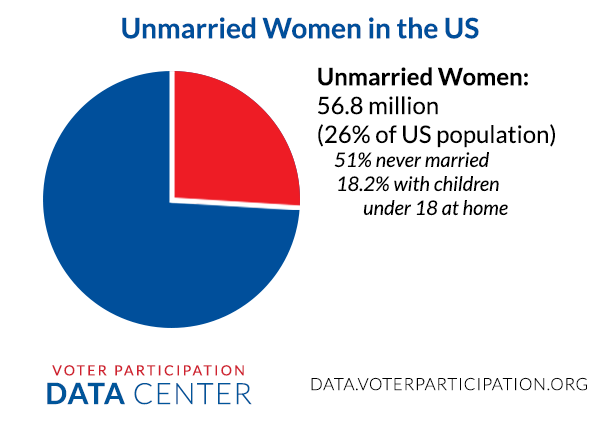
Unmarried women are on a trajectory to equal or surpass the number of married women by the November, 2016 presidential election.
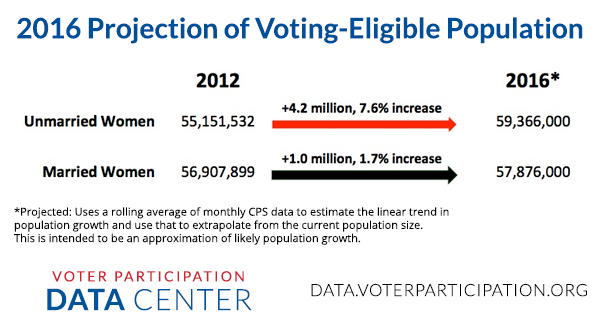
Unmarried women skew young and old:
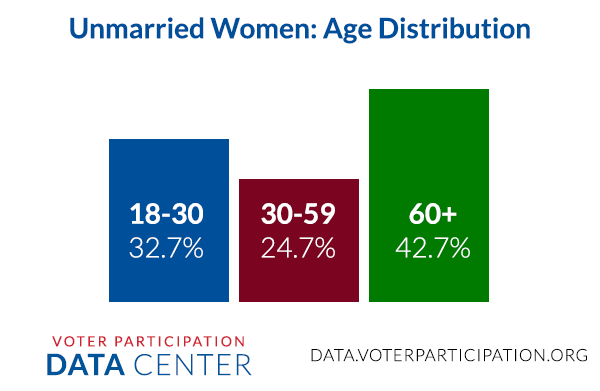
More than six in ten unmarried women in America are white.
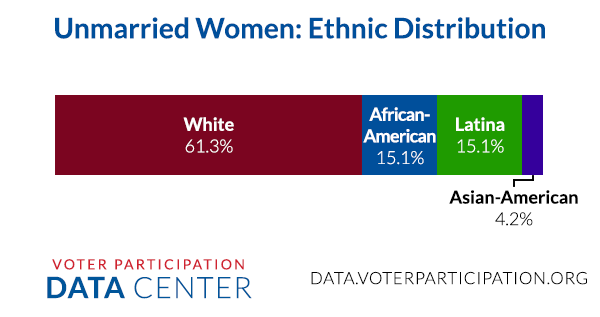
Education & Economics
A significantly higher percentage of married women (37.5 percent) have college and higher degrees than unmarried women (24.1 percent).
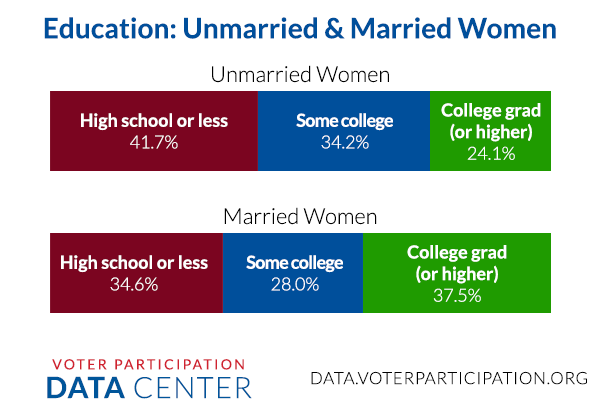
An unmarried woman was more than twice as likely to be unemployed (7.3 percent) as a married woman (3.1%).
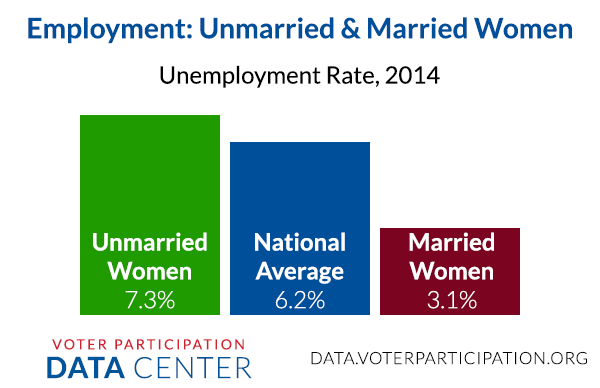
15.4 percent of unmarried women did not have health coverage in 2013—almost twice the rate for married women (8.3 percent).
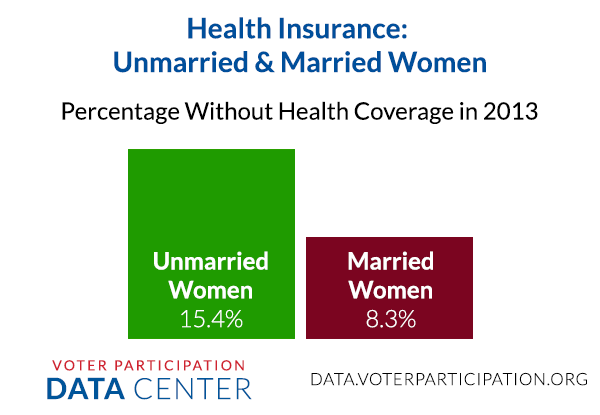
Unmarried women are disproportionately at the lower end of income brackets.
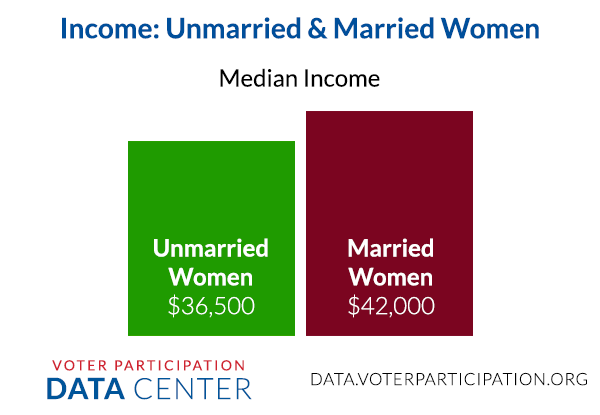
Women working full time make 80 cents for every dollar a man working full time makes. Unmarried women make substantially less. Latinas make the least of all unmarried women.
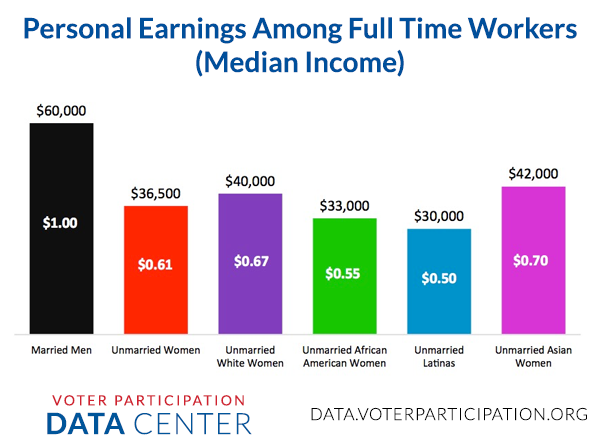
Unmarried mothers make significantly less than their married counterparts.
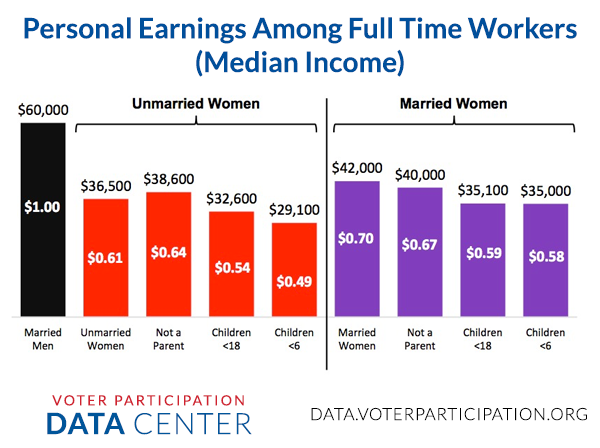
Unmarried women are almost four times as likely to live in poverty as married women.
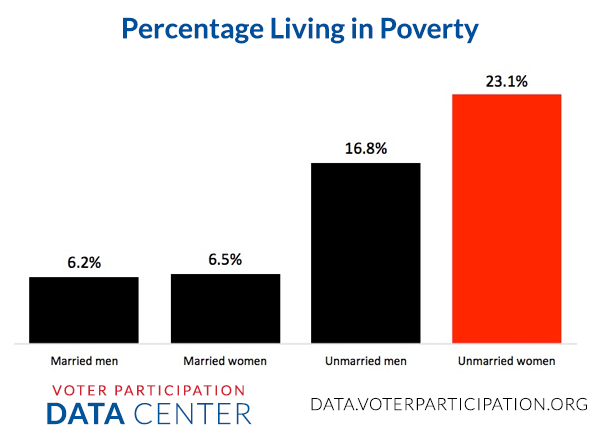
Unmarried women are less likely to be homeowners.
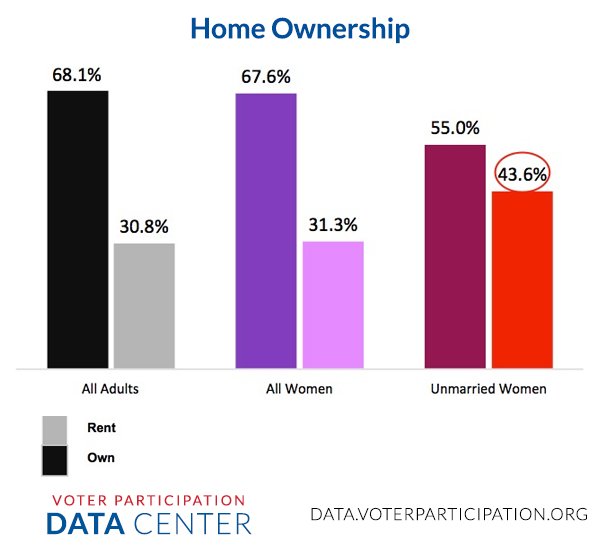
Over half of unmarried women do not have a employer-provided pension plan.
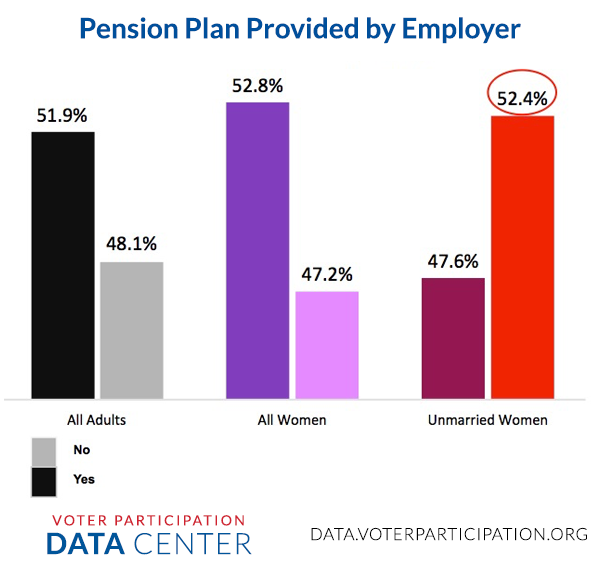
An in-depth demographic, economic and political look at unmarried women and the Rising American Electorate from Lake Research Partners.
- Unmarried Women: A Demographic and Economic Profile
- Unmarried Women: An Electoral Profile
- The Rising American Electorate: A Profile
- How the Rising American Electorate Register and Vote
- The Rising American Electorate: A Population` on the Move
The Ultimate Research Guide to Unmarried Women and the 2014 Elections
The Voter Participation Center and Lake Research Partners today are releasing the Ultimate Research Guide to Unmarried Women and the 2014 Elections. An invaluable resource for political observers, activists and the media, the Guide contains detailed information on unmarried women and other members of the Rising American Electorate, key voting blocs that will determine election outcomes in 2014, 2016 and beyond.
The Ultimate Research Guide analyzes data from the Census Bureau’s Current Population Survey (CPS), and details the growing political power of unmarried women voters. The report finds:
- Unmarried women are among the fastest growing demographic groups, with the largest growth since 2000 in sheer numbers: 10.4 million new eligible voters as November 2012, a 23.2% increase.
- Over 55 million unmarried women are eligible to vote, comprising 25.6% of the voting eligible population.
- In the 2012 presidential election, unmarried women were underrepresented, comprising only 24.0% of voters.
- Married women are more likely to register and vote than unmarried women. However, unmarried women are narrowing the gap, registering to vote and voting in increasing numbers.
The Voter Participation Center coined the term Rising American Electorate (RAE) to describe the voting group that includes unmarried women, people of color and young people aged 18-29. RAE voters helped re-elect President Obama in 2012. And the Republicans in their post-election “autopsy” vowed to broaden their base and appeal to these voters, “especially in Hispanic, African American and Asian Pacific communities.” Our research shows that unmarried women (divorced, separated, widowed, never married) are the largest segment of the RAE voting bloc. They are registering and voting at unprecedented levels and their civic engagement is critical to any candidate’s success.
Downloads
Anticipating 2014 Voter Drop-Off
This report, compiled by the Voter Participation Center and Lake Research Partners, highlights the potential drop-off in voter turnout looking ahead to the 2014 election, particularly that of the Rising American Electorate (unmarried women, people of color, and young people).
Downloads
August 2012 Updates
Downloads
A Roadmap for Reaching Unmarried Women
Unmarried women represent one of the largest untapped pools of potential voters and they have the potential to have an enormous influence on American politics and policies. That’s if they register and turnout. Identifying and using trusted communications channels are keys to increasing the participation and amplifying the voice of unmarried women in our democracy. To that end, The Voter Participation Center and Lake Research Partners have prepared a road map for reaching unmarried women.
Unmarried women — divorced, separated, widowed or never been married –are a large, politically powerful and rapidly growing part of the electorate:
- Unmarried women make up more than 25 percent of the U.S. population.
- They grew faster in sheer numbers than any other demographic group between 2000 and 2010 and saw a huge increase – 20% – compared to a 7 percent increase for married women — in the number of eligible voters since 2000.
- Marital status is a key determinate of electoral participation. Unmarried women are considerably less likely to register or vote than their married counterparts and their level of political involvement falls short of their potential.
- In addition to their sheer size and growth rates, they are also the key to reaching other politically under-participating, under-represented groups. They are the largest segment and the primary driver of the Rising American Electorate (RAE.) Together, unmarried women, people of color and young people make up the majority (53 percent) of the eligible U.S. voters. And unmarried women make up a large percentage of the Latino and African-American populations and of young people under 30.
- Their participation in 2008 made a major difference as it could in November 2012, when 55 million unmarried women will be eligible to vote.
The 2008 Presidential election was a strong demonstration of the power and potential of this vote. That year, President Obama carried unmarried women 70 -29 percent over John McCain. And this year, according to the Quinnipiac University national poll released on July 11, President Obama’s 46 to 43 percent lead over Governor Romney is being “driven by a yawning marriage gap, and a 2-1 lead among single women.” According to the poll, Romney leads 49 – 42 percent among married women; Obama leads 60 – 31 percent among unmarried women. “Although much has been made about the gender gap and how President Barack Obama’s lead among women fuels his campaign, the marriage gap is actually larger and more telling,” according to Peter A. Brown, assistant director of the Quinnipiac University Polling Institute.
But 39 percent of eligible unmarried women are unregistered, compared to 28 percent of married women. And even though unmarried women will be deeply and directly affected by the outcome of the 2012 elections and the economic, health care and education policies that will be pursued after the election, they are not active seekers of political news or election coverage. The 2008 “surge” vote will not reappear in 2012 unless outreach and communications designed to give them a stake in the outcome of the election starts now. That’s why we are making the report, Unmarried Women: How They Get News and Information, available to ensure that these women are actively engaged by as many different groups and organizations as possible. The goal is improve the accuracy of their targeted communications, to ensure they are reaching – and being heard by– single women.
Highlights from “Unmarried Women: How They Get News and Information:
- These women are busy, move much more than other voters, feel disconnected from politics, and are often put off by “political information.” Unmarried women are highly skeptical and less likely to trust news sources than adults overall.
- They are not watching political television channels, listening to political talk radio or reading political blogs. More than seven in ten (72 percent) express moderate to no interest in politics – significantly higher than adults overall (61 percent)
- The key to reaching unmarried women is reaching out to them through non-political channels and where they live and interact. The information has to reach them where they are, be local, and directly apply to their daily lives even more so than for other groups of voters.
- Unmarried women get news and information from local TV news, online weather, health and entertainment sites and from talking with others. Eight in ten unmarried women have gotten news in the last month from talking with others.
- Television, especially local television, remains a dominant source of news for these unmarried women.
- Cable television is also an effective way to reach these women. Some of their favorite shows air on Lifetime, TLC, TBS, TNT, A&E, and the Food Network. MTV is important for the never married women.
- There is a strong age difference in news gathering: younger unmarried women under 50 are much more likely to use the Internet to get news about the election than older women (34% to 9%); older unmarried women still tend to have regular news viewing habits, tuning in for regularly scheduled newscasts; younger unmarried women check in on the news on an irregular basis and are less likely to wait for the “News at 11.”
- Unmarried women tend to see the news on their customized home pages on the web.
- These women gravitate toward sites supplying weather, directions, and health information. They look for news they can use – including money saving tips and restaurant reviews. Unmarried women also like entertainment news and websites.
- All unmarried women rely on information received by word of mouth. Social media is a powerful way to trigger these in-person conversations for younger women; for older women, younger friends and family can spark this conversation.
- Two-thirds of unmarried women – like adults overall – use their cell phones for more than calls. But younger single women (under 50) are much more likely (81 percent) than older women (44%) to use their phones for other things than calls. Texting is a powerful and effective tool for communicating with younger unmarried women.


